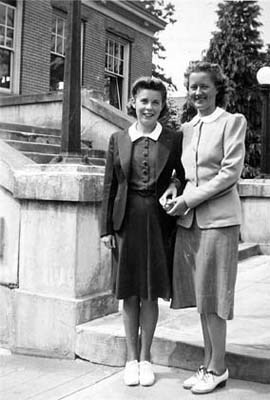When Burnaby was incorporated as a municipality in 1892, there were an estimated 300 people living within its borders.
Today, 120 years later, there are more than 220,000 people living in the city, making it the 20th largest municipality by population in Canada.
In the intervening years, the seat of municipal power has grown accordingly.
The first city hall was built in 1899, seven years after incorporation (and seven years after the first-ever council held its meeting at Sample's Boarding House on Beresford Street). Located at Kingsway and Edmonds Street, the new city hall was near the bulk of the city's population at that time, in South Burnaby, and near the tram line, which travelled through the city from Vancouver to New Westminster.
That original wood building later became a public hall and then was demolished in 1962 to make way for the Edmonds branch of the public library.
The second city hall, a large brick building - which can be seen behind the two young women in the photo below right - was built in 1911 not far from the original building and would be used for more than 40 years.
It later served as a police headquarters and was eventually torn down in 1970.
For 10 years starting in 1932, the provincial government took control of the city as a result of the ongoing Depression; the city was run by a commissioner, and the province was responsible for welfare for the unemployed.
But in 1942, with the war in Europe still raging and the economy improving, Burnaby returned to its own elected council.
The current city hall on Canada Way was built in 1956. It was considered to be thoroughly modern and reflective of the growing city. With development in North Burnaby booming after the Second World War, the new location represented "central" Burnaby much better than the former South Burnaby location.
The building cost $625,000 and was officially opened on June 22, 1956 by then-Reeve Charles MacSorley.
By then, the city's population had grown to more than 75,000.
Today's city hall has had an update or two over the years and, in 1975, the facility got a significant expansion with the construction of the "west building."
In 1992, Burnaby became an official city.
The city has 1,516 regular full-time and regular part-time staff working at facilities around Burnaby. Of those, 608 - more than twice the population of the entire city in 1892 - are located at city hall itself.
Among them are Blanka Zeinabova, an administrative officer, and Therese Nielsen, from the planning department (see photo below left). They are just two of the hundreds of staff who help run what is now the province's third-largest city.
DATELINE 1940
Canada was at war in 1940 - and would remain so for another five years. Mackenzie King won a second consecutive majority in Ottawa and, for the first time, unemployment insurance was introduced.
In Burnaby, the crippling impact of the Depression was slowly lifting.
After a decade of provincial control, an elected council returned to the city in 1942, returning to the city hall building seen in the background of the photo below. That structure was built in 1911.



